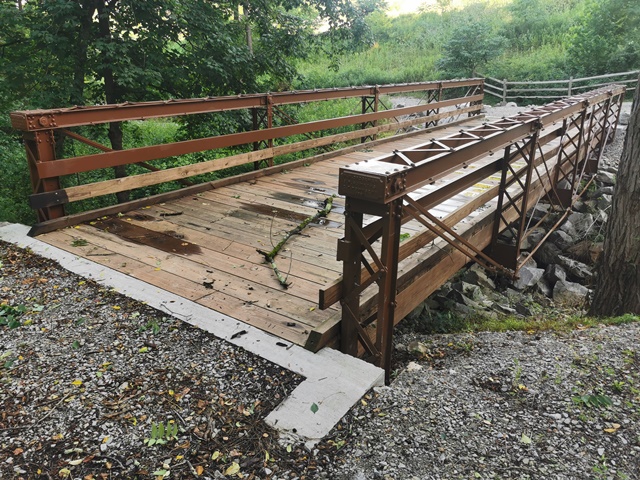We Recommend:
Bach Steel - Experts at historic truss bridge restoration.
BridgeHunter.com Phase 1 is released to the public! - Visit Now
Potter Bridge
Thompson Hill Park Bridge

Primary Photographer(s): Nathan Holth
Bridge Documented: July 23, 2022
Rural: Washington County, Pennsylvania: United States
2021
44.0 Feet (13.4 Meters)
47.0 Feet (14.3 Meters)
9.8 Feet (2.99 Meters)
1 Main Span(s)
627230036040080

View Information About HSR Ratings
Bridge Documentation
View Archived National Bridge Inventory Report - Has Additional Details and Evaluation
This bridge has been relocated and preserved for pedestrian use at Thompson Hill Park. Please also see HistoricBridges.org's page for photos and documentation of the bridge in its previous, original location.

This bridge is a very old wrought iron truss bridge with an 1881 construction date. However, this bridge's extremely high level of historic significance arises from its highly unusual, if not unique, truss arrangement. First, the bridge features vertical endposts, yet is NOT a bedstead. Pony truss bridges with vertical end posts are very rare. Even more rare and unusual however is this bridge's bottom chord, which within the end panels runs from its standard position below directly up to the top chord / end post connection. As such, there is no bridge material between the first bottom chord connection and the bottom of the end post. This design of bridge may be one of the last examples of its type in the country.
The bridge retains a high degree of historic integrity. The main alteration is the railings on the bridge which are not original. However everything else on the bridge appears to be remarkably complete and unaltered.
This is a very small bridge with an extremely high level of historic significance. Thankfully, this bridge became one of the first metal truss bridges in southwestern Pennsylvania to be relocated and preserved for pedestrian use. The bridge is located in a secluded picnic area, allowing people to view the bridge will having a picnic. This process is an outstanding way to give historic metal truss bridges new life and functional use, and it is hoped this project will serve to inspire similar projects elsewhere in southwestern Pennsylvania.
Information and Findings From Pennsylvania's Historic Bridge InventoryDiscussion of Bridge The single-span, 47'-long, pin-connected Pratt pony truss bridge was built in 1881 according to the plaque, and it has vertical end posts and the floor beams placed above the lower chords. The trusses are traditionally composed, but the basic shape of the truss lines with the squared end posts and absence of lower chords in the end panels results in the need for vertical posts to transmit the reactions to the abutments. It is an archaic and uncommon design. The design does concentrate section at the middle of the truss where bending is the greatest. The bridge is historically and technologically significant based on its date of construction and design. It reflects the period of experimentation that characterized the early days of metal truss development. Discussion of Surrounding Area The bridge carries a single-lane road with horizontally curved approaches over a stream in a sparsely developed, wooded setting. Bridge Considered Historic By Survey: Yes |
This bridge is tagged with the following special condition(s): Unorganized Photos
![]()
Photo Galleries and Videos: Potter Bridge
Bridge Photo-Documentation
Original / Full Size PhotosA collection of overview and detail photos. This gallery offers photos in the highest available resolution and file size in a touch-friendly popup viewer.
Alternatively, Browse Without Using Viewer
![]()
Bridge Photo-Documentation
Mobile Optimized PhotosA collection of overview and detail photos. This gallery features data-friendly, fast-loading photos in a touch-friendly popup viewer.
Alternatively, Browse Without Using Viewer
![]()
Maps and Links: Potter Bridge
Coordinates (Latitude, Longitude):
Search For Additional Bridge Listings:
Bridgehunter.com: View listed bridges within 0.5 miles (0.8 kilometers) of this bridge.
Bridgehunter.com: View listed bridges within 10 miles (16 kilometers) of this bridge.
Additional Maps:
Google Streetview (If Available)
GeoHack (Additional Links and Coordinates)
Apple Maps (Via DuckDuckGo Search)
Apple Maps (Apple devices only)
Android: Open Location In Your Map or GPS App
Flickr Gallery (Find Nearby Photos)
Wikimedia Commons (Find Nearby Photos)
Directions Via Sygic For Android
Directions Via Sygic For iOS and Android Dolphin Browser
USGS National Map (United States Only)
Historical USGS Topo Maps (United States Only)
Historic Aerials (United States Only)
CalTopo Maps (United States Only)

